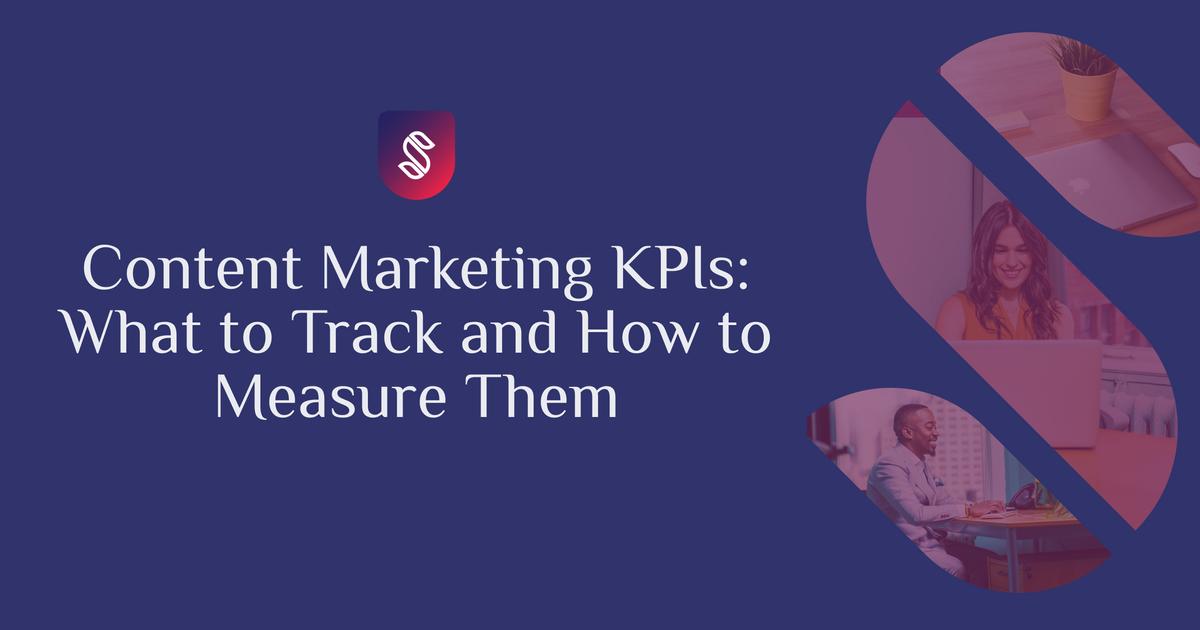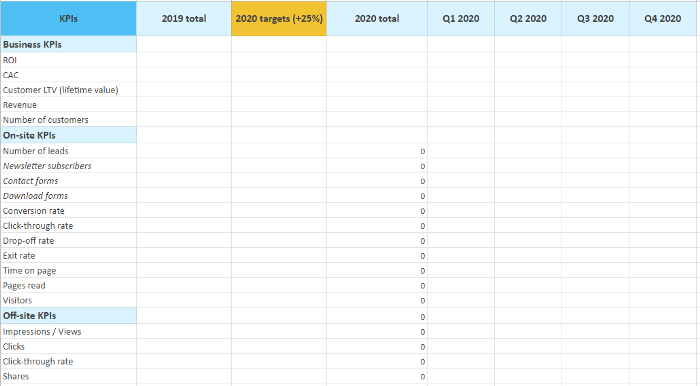Written on 9th August, 2022 | 5 min read
Content Marketing KPIs: What to Track and How to Measure Them
A practical guide for setting and measuring content KPIs
Andreea Macoveiciuc
Strategist @School of Content

When you set content marketing KPIs, always start with your company's business and marketing goals.
If your company aims to acquire 100 new customers in the next quarter and the entire marketing department is responsible for 50% of this number, then content marketing can probably acquire 10-25%.
In real life though, you don't want to guess and come up with numbers based on intuition. So in this article, I'll show you a data- and goal-driven approach to setting content marketing KPIs.
Content marketing KPIs: what to measure
In big lines, your content KPIs should show very clearly how content marketing is contributing to the overall business and marketing goals. For this reason, I like to split the metrics into three groups:
Business KPIs
On-site KPIs
Off-site KPIs
The business KPIs include the following metrics:
ROI
CAC
Customer LTV (lifetime value)
Revenue
Number of customers
Or, in case of SaaS products:
Number of leads
Number of MQLs
Number of SQLs
Number of customers
Conversion rate lead:MQL
Conversion rate MQL:SQL
Conversion rate SQL:customer
Revenue
These refer strictly to your content marketing efforts, so the ROI of content, the CAC of content, the number of customers acquired with content marketing, and so on. In the next section, I’ll show you how to measure each of these.
The off-site KPIs include:
Impressions or views
Clicks
Click-through rate (CTR)
Shares
These can be tracked as a total or per channel (organic, social, e-mail, referrals), depending on how granular you want to go.
Finally, your on-site KPIs will include:
Number of leads
Conversion rate (CR)
Click-through rate (CTR)
Drop-off rate
Exit rate
Time on page
Pages/session
Visitors — which can be split into new and returning
Depending on your service or product, you can also add here goals like:
Newsletter subscribers
Forms filled in
Book downloads
Videos watched
Scroll depth etc.
Why do we split the on-site and off-site metrics?
In my experience, it’s more efficient to look at these numbers separately, as it helps you identify gaps and areas that are underperforming.
For example, if you’re getting a lot of impressions in SE but no clicks, your meta titles and meta descriptions might need some extra attention. If you’re getting no engagement or referrals from social channels and communities, you might need to revise your strategy per channel and so on.
Attribution models for content marketing
Before diving into the measuring part, we have to clarify one aspect: in order to attribute a lead or a customer to the content marketing channel, you need to discuss with your team what attribution model you’ll use.
You can use the first-click attribution model if you want to attribute to content marketing all leads/customers that started their journey on your website with a blog article or landing page.
So the first-click refers to the first interaction with your website. If a user Googled something and saw one of your blog articles in the organic results, then clicked it and landed on your website, their first interaction is attributed to content marketing efforts.
The last-click attribution model is the opposite: it attributes to content marketing any lead or customer that ended their journey on your website with a content piece. This means that the last page they’ve visited before converting was a blog article or landing page.
Unfortunately, none of these models gives the full picture. You can, therefore, use a third model for getting a better overview of the overall impact that your content is having on the number of visitors, leads, and customers.
This third option is usually referred to as multi-touch attribution. This model gives credit to content marketing for any lead or customer that interacted with the blog or landing pages once in their journey, before converting.
As said, you can choose one of these models or all three — the most important part here is to have an agreement within your team so that everyone tracks and reports using the same logic.
Now let's see how to measure your content KPIs.
How to measure your content marketing KPIs
For this example I’ll use a spreadsheet, so you can easily access the template. Let’s add all the metrics mentioned until now into this spreadsheet.
To make our goals SMART, we’ll add a column for the time interval that we want to track. And for determining our targets for the quarter or year, we’ll look at the numbers from the previous interval.

Image: content marketing kpis template
Customer lifetime value (LTV)
Customer LTV is the lifetime value of a customer acquired through content marketing.
LTV = Average customer lifespan x Customer value
How or where do you find these numbers? In your CRM most likely.
Cost of acquisition (CAC)
The cost of acquisition takes into consideration the revenue attributed to content marketing, as well as the total costs — including technology costs, salaries, paid ads, etc.
The formula for calculating the content CAC is:
CAC = Total costs / Traffic x Conversion rate
Content marketing ROI (return on investment)
With the two numbers above you can now determine your content marketing ROI. Use the formula below:
ROI = LTV/CAC
This is probably the most important metric in a company where content is seen as any other performance channel.
If, however, your management team thinks of content marketing as an awareness channel exclusively, they might care less about these numbers, and more about metrics like traffic, views, and marketing-qualified or sales-qualified leads.
If you need help in analyzing your content performance and extracting insights from your data, get in touch with our team. We'll audit your content, set KPIs and build a dashboard that gives you the full picture.
Metrics in Google Analytics & Search Console
Most of the remaining KPIs can be taken from your GA or GSC account. The attribution models mentioned above can be found under Conversions > Multi-Channel Funnels > Model Comparison Tool.
Here’s an example from a B2B company that uses its blog to acquire leads for the sales team. They’re not selling anything on the website, and the blog is used purely for showing their expertise in the field.

Image: content marketing results b2b
Results are for the first half of 2020, and in their case, visitors who find their website through organic search, social media, or referrals convert better in the first-click interaction model.
Here’s another example from a B2C company, this time for Q2 only.

Image: content marketing results b2c
If we would look only at the first two models, we’d be tempted to think that the referral channels aren’t producing any result. However, in the linear model, we see that this channel is also slowly picking up.
Coming back to our metrics: the on-site KPIs can be measured in Google Search Console. For measuring your social shares, check your social analytics reports. The on-site KPIs can be found in your Google Analytics reports.
I hope this gives you a bit of direction in setting content marketing KPIs and proving the impact of your content efforts on the overall number of leads, customers, or revenue.
If you need help with your content goals or metrics, don't hesitate to contact our team!